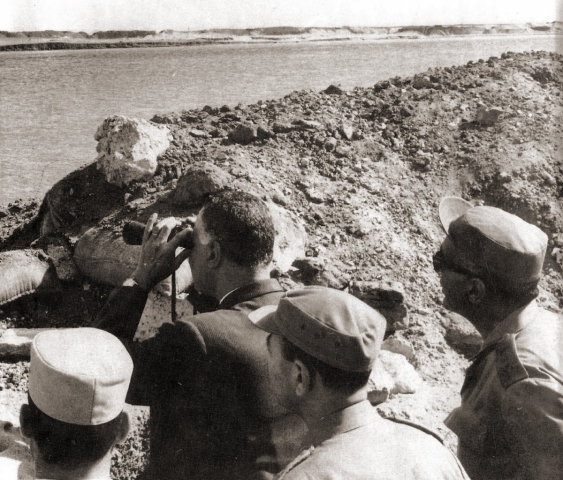On March 8th, 1969, the Egyptian armed forces launched a major offensive at Israeli positions on the eastern parts of the Israeli-controlled Suez Canal, beginning the War of Attrition that lasted until August 1970.
On June 11, 1967, after the Six-Day war, a ceasefire had been reached between Israel and Egypt. Despite the ceasefire, by October 1968, Egypt had begun launching commando attacks and artillery fire at Israeli positions along the canal, even sinking an Israeli destroyer off the Sinai coast. Israel reacted by standard retaliatory raids. As Egyptian attacks continued to increase, Israel designed and constructed a defense fortification system along the canal known as the Bar-Lev Line, named after the Chief of Staff.
On February 16, 1969, Egyptian tyrant, President Gamel Abdel Nasser convinced his government ministers that launching an extreme war of attrition against Israeli positions in Sinai, Egypt could put a strain on Israel’s military capability, and therefore eventually win back Sinai through military force and persistence.
Never too late to learn.
— Eyal (@TelAvivbroker) April 28, 2020
Read today that in 1970, during the war of attrition between Egypt and Israel there was a dogfight between 24 Soviet pilots in Mig-21's and 16 Israeli pilots in F4's and Mirage planes. In 6 minutes Israel downed 5 Soviet planes and suffered no losses.
Nasser also thought that by attacking IDF posts in the Sinai, in which most of the soldiers were reservists, the Israeli economy would be impacted as well; something that never really came to fruition. Nasser further believed that these limited yet achievable goals could influence the United States to reevaluate its policy for the region, just as President Nixon was taking office.
Nasser wanted Nixon to intensify the pressure on Israel into negotiating an agreement that would strongly favor Egypt. Nasser also counted on the notion that an escalation along the canal would help boost morale, which was tarnished after the Egyptian defeat of 1967.
As part of our series marking #Israel’s 75th we are remembering the War of Attrition.
— We Believe in Israel (@WeBelieveIsrael) March 3, 2023
The War of Attrition was a military campaign conducted by Egypt designed to wear #Israel down through a long and exhausting engagement. pic.twitter.com/CqARmp79ji
The hostilities that began on March 8th intensified, yet would largely be underreported by Israeli media, due to the heavy euphoric atmosphere that came with the victorious Six-Day war. Israel responded to the Egyptian attacks with heavy shelling, killing Egyptian Chief of Staff General Abdul Munin Riad. Both sides continued the attrition tactics throughout March and April with Israel responding to Egyptian attacks with commando raids that may have even reached the outskirts of Cairo.
Nasser would ultimately turn toward the Soviet Union for increased military support, which was given to him in the form of surface-to-air missiles in early 1970.
https://t.co/tBNjQ23tzf
— 🚜 🇺🇸 🇸🇦 🇮🇱 🇮🇳 Indict World Economic Forum (@wakoppa) July 15, 2019
The War of Attrition is virtually forgotten today,
March 8, 1969 - August 7, 1970.
The War of Attrition morphed into a proxy war between the United States, Israel’s ally, and the Soviet Union, Egypt’s chief arms supplier.
The United States responded to the combative situation with a plan to bring the fighting and conflict to an end. Presented by Secretary of State William Rogers, the plan called for virtually full Israeli withdrawal from Sinai, Egyptian recognition of Israel, freedom of navigation for Israeli ships, and a resolution to the refugee problem. A ceasefire was agreed upon in August 1970, but the peace agreement would come later, leading Israel to only fully withdraw from the Sinai by 1982.


